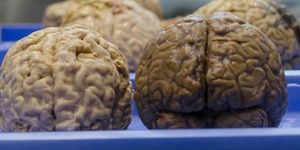What is Lewy Body Dementia?
Dementia is a scary diagnosis, but what many people don't realize is that dementia is a general term that can refer to age-related cognitive decline or can be present in several neurodegenerative diseases including vascular dementia, Alzheimer's disease, Parkinson's disease and Lewy body dementia (LBD.) Actor Robin Williams, who committed suicide at the age of 63 in August of 2014, had been diagnosed with LBD and it's believed that the disease contributed to his death.
Another celebrity, cable television mogul Ted Turner, recently revealed that he has LBD and his openness on the topic is raising awareness of a disease many don't understand. First, the name. Who or what is a Lewy body? In 1912, Dr. Friederich Lewy, a German neurologist discovered abnormal protein deposits that disrupt the brain's normal functioning, but he found them, at first, only in patients with Parkinson's disease. This is how we now know that Lewy body dementia encompasses two related diagnoses: Parkinson's disease dementia and dementia with Lewy bodies.
In the brain, what happens is that clumps of a protein called alpha-synuclein accumulate and interfere with cognition, movement, and mental health. It's difficult to diagnose because early symptoms can be similar to symptoms of depression, schizophrenia, and Alzheimer's. The cause, however, is the same, a build-up of alpha-synuclein that impairs the function of several body systems. It's a progressive disease, that typically shows up around age 50, so many patients think their movement problems or forgetfulness is just normal aging. Men and women are affected at almost the same rates, with slightly more cases seen in men.
There are an estimated 1 million people in the United States with a diagnosis of Parkinson's disease dementia or LBD. There is no cure. While progression speed varies from patient to patient, the disease has an average span of 5-8 years between diagnosis and death. Most patients with LBD die from related causes, not the disease itself. Since it affects muscle control, falls are very common as are autonomic issues like blood pressure instability, heart rate variations and difficulty swallowing which can lead to aspiration pneumonia.
While there is no cure for LBD, there are some treatments, which if taken in the early stages of the disease, can provide a better quality of life for patients. First line medications include cholinesterase inhibitors which can relieve some of the cognitive symptoms of memory loss and processing speed. Initially, these drugs were developed for Alzheimer's patients. However, some studies show that they are more effective in patients with LBD. A Parkinson's drug, called levodopa, can ease of rigidity and muscle weakness that is common in LBD patients and is sometimes helpful in preventing falls.
LBD can have psychiatric symptoms as well, such as visual hallucinations which are incredibly lifelike and very distressing to patients and their caregivers. Anti-psychotic medications can treat these symptoms in patients with mental illness, but in those who have LBD, they can be dangerous. Research studies show that up to 50% of patients with LBD who take psychiatric medications can experience neuroleptic sensitivity. What this means is that the disease can have worsening symptoms at a faster rate including impaired cognition, increased sedation and even irreversible parkinsonism such as muscle rigidity and spasm. A rare condition called neuroleptic malignant syndrome (NMS) can cause high fevers and renal failure, often leading to death. Check out the video below from CBS Sunday Morning where Turner discusses his diagnosis and his long career in media.
Sources: National Institute on Aging, Lewy Body Dementia Association, CBS News









